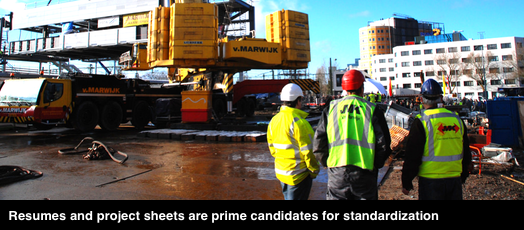Standardizing content allows proposal teams more time to build out their strategies, improving both efficiency and quality. This post looks at two ideal standardization candidates—resumes and project descriptions.
Like all proposal content, resumes and project sheets descriptions need to:
- Comply with requirements
- Show understanding of the project and the prospect
- Position the proponent as best qualified to deliver excellent results
- Enable proposal evaluators to award maximum points based on a quick read
Approach to standardization
Decide on the items you intend to include, and identify those you’ll want to customize for each project. Set up a two-column table, with the names of items in the (narrow) left-hand column rows and the corresponding content on the right.
The sections below show typical categories of information for resumes and project sheets. We’ve underlined the items you’ll likely need to customize.
Resumes
Use resumes to show evaluators you understand the key roles required for the project, the knowledge and experience needed for those roles, and and that you’ve staffed each role with a fully-qualified individual. See below for typical content categories:
- Photo (only if you have similar, high quality photos for all individuals)
- Name and professional designation(s)
- Current employer, position/title and years of experience
- Proposed role in the project—three to four sentences describing responsibilities
- Qualifications—four-to-six points supporting your choice of this individual for this project
- Profile: A two- or three-sentence summary of the individual’s strengths and experience
- Reverse order chronology of recent roles (or projects), including responsibilities and positive impact made. Use a separate row for each role or project and structure the information for each consistently.
- Education, certifications, awards and recognition
Some RFPs ask for additional information, such as the percentage of time each key individual will be committed to the project. Include this as part of the proposed role description or as a separate row in the template.
Project descriptions
Like resumes, project sheets need to show understanding of the RFP project. The template below is generic; you may need to add categories relevant to your business. Construction project sheets, for example, typically require original and final contract value and completion dates with explanations of any variances.
- Photograph
- Project name
- Name of client
- Measures of size (for example contract value) and completion date
- Relevance to RFP project—four-to-six points
- Description—what problem was the project resolving?
- Innovations, challenges overcome
- Individuals involved who overlap with the current project
- Evidence of success and excellence
- Reference—name, title, organization, email address, telephone number
Always align content with RFX requirements
Some RFPs (RFQs, RFIs) detail the contents of resumes and project sheets. In this case, use the same language and order as specified in the RFP document. If you’ve put careful thought into developing standard resumes and project sheets, you’ll be able to adapt them with minimum effort.
RFPs in many industries specify maximum lengths for resumes and/or project sheets.—usually two pages for resumes and three for project sheets. If typical RFPs you see contain these limitations, make your standard versions the same lengths.
Photo credit


